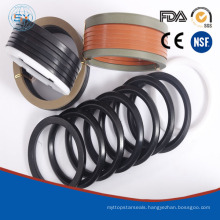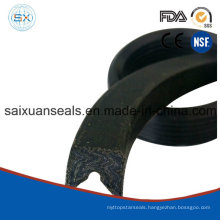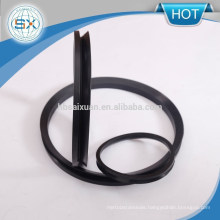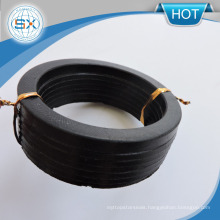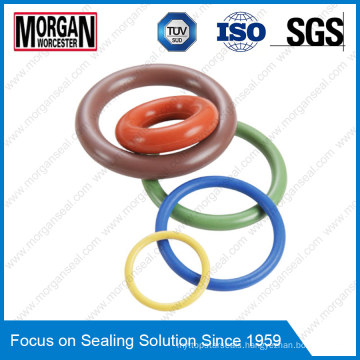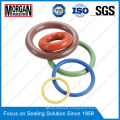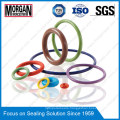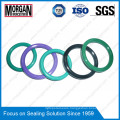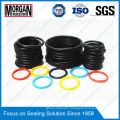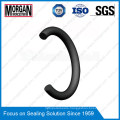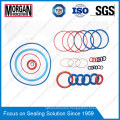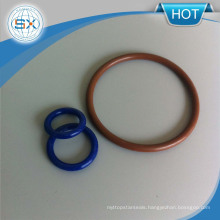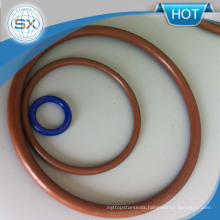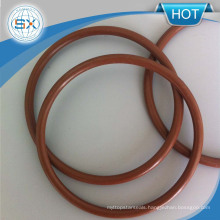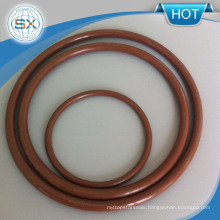ISO/DIN/JIS/As568/GB NBR/HNBR/FKM/EPDM/Silicone Rubber O Ring
Basic Info
Model No.: O-ring
Product Description
Model NO.: O-ring Application: Every Field of Industry Performance: Fix and Sealing Standard: Standard OEM/ODM: Yes Pressure Data: 0-60MPa(According to Material) Working Media: Air, Oil, Gas, Water etc Dimension Standard: DIN/JIS/As568/GB3452 Standard Specification: all series HS Code: 4016931000 Material: NBR/FKM/EPDM/Silicone Rubber or Customized Type: Both Static and Dynamic Seal Shape: O-Ring Certificate: ISO 9001:2008 Production Period: Within 30 Days Color and Dimension: Accept Customized Products Factory Visiting: Welcome Trademark: morgan Origin: China DescriptionThe O Ring , because of their simple shape and efficiency, have been used for a number of years in diverse industrial applications - valves, industrial engines, medical equipment, agricultural equipment and construction machinery, machine tools, etc. In short, in situations where a compact design is required for a good sealing effect. These O Rings are made (among others) from very varied chemical synthetic rubber: NBR, EPDM, HNBR, FKM, VMQ, ACM, AEM, as well as Polyurethane, PTFE, FKM-FEP or VMQ-FEP, which provides a large selection of materials that are chemically compatible with a wide range of products and fluids. The dimensions of the housing are defined by the O'Ring cross-section Ød2. These O-Ring are extremely easy to use, both for static and dynamic applications, and do not require any maintenance or adjustment. They can be used under pressure and at significant speeds and temperatures by selecting the right quality and by carefully following the installation instructions. The O-Rings are a simple, efficient and economic solution. Advantages
Compact design
Easy assembly
Economic solution
Symmetry that reduces the risks of an assembly error
Applications
O-Rings are used in a variety of fields: they are either used as sealing elements or as energizing elements for hydraulic slipper seals and wipers. Thus, the O-Ring is basically used in every field of industry including aerospace, automotive or general engineering. Today, O-rings are one of the most common seals used in machine design because they are inexpensive, easy to make, and reliable and have simple mounting.
Materials
Morgan O-rings Material Includes Nitrile rubber, fluorine rubber, ethylene propylene rubber, neoprene, chloroprene rubber, silicone rubber and so on.
NBR (Nitrile Butadiene Rubber)
Nitrile rubber (NBR) is the general term for acrylonitrile-butadiene copolymer. The ACN content can vary between 18% and 50%. While the acrylonitrile content is important, the resistance to oil and fuel is more so. Conversely, the elasticity and compression set are not as good. The NBR has good mechanical properties and good wear resistance. However, its resistance to atmospheric agents and the ozone is relatively low.
FKM (fluorinated rubber)

Depending on their structure and fluorine content, fluoroelastomers can vary in terms of chemical resistance and resistance to cold. This FKM-based rubber is very often used for high-temperature hydraulic and pneumatic systems, industrial valves, injection/fuel systems, motor seals and high-vacuum systems.
EPDM (Ethylene Propylene Diene Monomer rubber)
As an Ethylene Propylene Diene Monomer copolymer, EPDM is commonly used for hot water taps, cooling systems, brake systems, dishwashers and washing machines.
HNBR (Hydrogenated Nitrile Butadiene Rubber)
This HNBR-based elastomer is obtained through selective hydrogenation of the NBR's butadiene groups. It is commonly used for power-assisted steering and for air conditioning.
VMQ (silicone rubber: methyl vinyl polysiloxane)

This FVMQ-based rubber is very often used for fuel systems.
FVMQ (fluorosilicone rubber)
The FVMQ has mechanical and physical properties that are very similar to those of VMQ. However, the FVMQ offers better resistance to fuels and mineral oils. However, resistance to hot air is not as good as that of VMQ.
ACM (Polyacrylate)
Polymers containing ethyl acrylate (or butyl acrylate) have a small amount of monomer, which is necessary for cross-linking; ACM is a material with better heat resistance than NBR. It is often used for automatic gearboxes.
AEM (ethylene acrylate rubber)
As a methyl acrylate and ethylene copolymer, AEM is considered to be better resistant to heat than ACM. Its characteristics make it an intermediary between ACM and FKM.
CR (Polychloroprene)
This CR-based elastomer is used in the refrigeration industry and for ventilation systems. This chloroprene was the first synthetic rubber to be developed and marketed.
FFKM (perfluorinated rubber)
FFKM has the best resistance to high temperatures and an excellent chemical inertia. This FKM-based rubber is very often used for high-temperature hydraulic and pneumatic systems, industrial valves, injection/fuel systems, motor seals and high-vacuum systems.
The table below gives an overview of the physical, chemical and mechanical characteristics for each of the materials.
1. excellent properties 2. Good properties 3. Average properties 4. Poor properties
Chemical compatibility
A "Chemical compatibility guide" catalogue can be downloaded from the Literature section. You can also use our online "Chemical compatibility" tool free of charge.
These two tools enable you to measure the behaviour of our materials that come into contact with the majority of existing fluids. The data displayed is the result of rigorous testing at the ambient temperature and takes previous publications into consideration. Test results are not fully representative because of the specific features of your application. The tests performed actually do not consider additives and impurities that may exist under actual conditions of use, nor the potential elevation of temperatures. Other parameters can also alter the behaviour of our materials, such as the hardness, persistence, abrasion, etc. We therefore recommend performing your own tests to verify the compatibility of our materials depending on your specific application. Our technical team can provide you with any additional information.
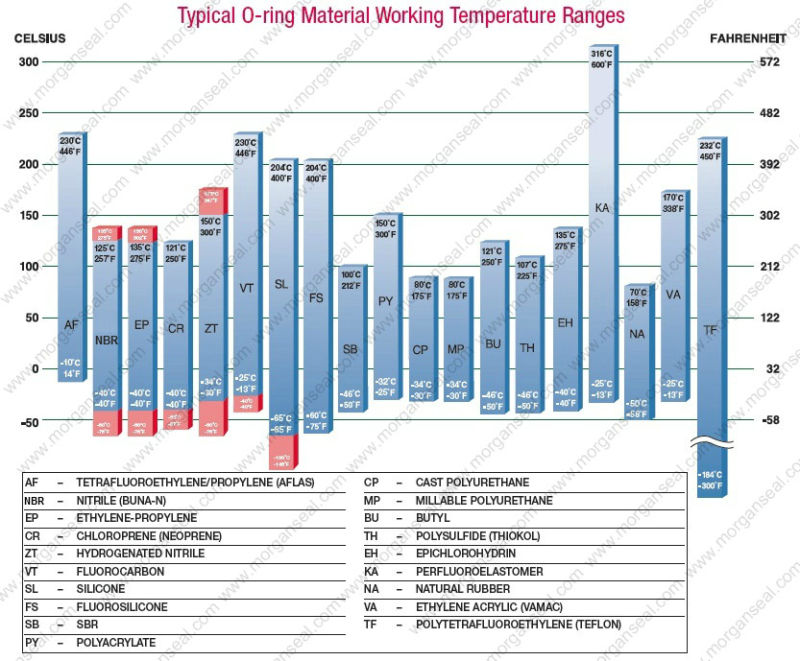
O ring standard:The o ring sizes are specified by the inside diameter and the cross section diameter. Morgan Rubber O ring seals are manufactured according to metric and imperial international standards such as GB3452.1-92, AS 568B, DIN ISO 3601 and JIS standard. Morgan seals also accept custom sizes of almost any dimension, such as metric o rings, miniature O-rings, special O-rings with large dimensions and continuously moulded and spliced.

Guangzhou Morgan Seals Co., Ltd. has the biggest vulcanizing machine(4000T) and different kinds of seal moulds. So for the non-standard o ring, Oil Seals, Hydraulic Seals, please do not hesitate to contact with us. The following is the the picture Morgan Production Line and Warehouse
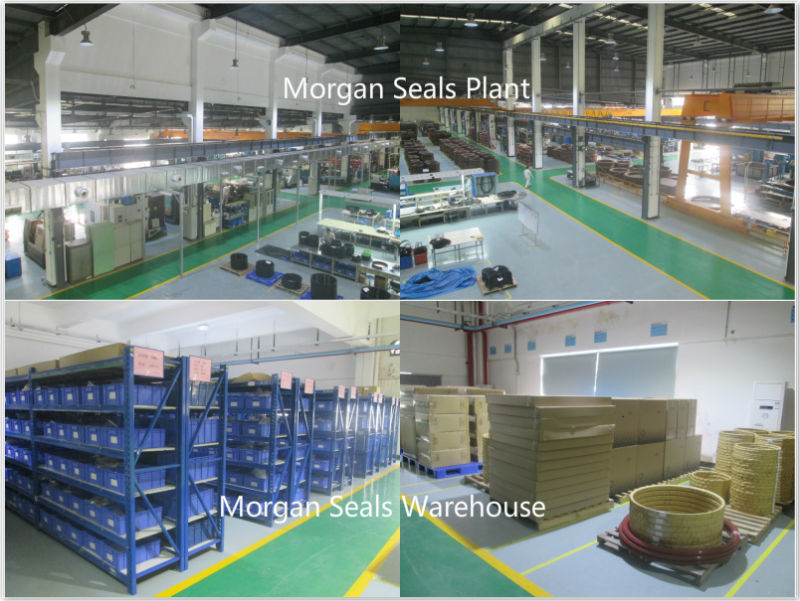
Our services:
Guangzhou Morgan Seals Co., Ltd the expert in sealing solution field who combines the rich seals research and production experience of her parent firm with the advanced technology and administration of Morgan, Worcester. Morgan Seals Research and Development ability is based on her parent firm who has won awards as scientific research achievements for more than 1000 projects and over 200 of them won scientific and technological progress prizes of municipal, provincial, ministerial and national levels. At the same time, it also has one National Certified Laboratory, one National Engineering Research Centers and three Industry Level Inspection Centers.
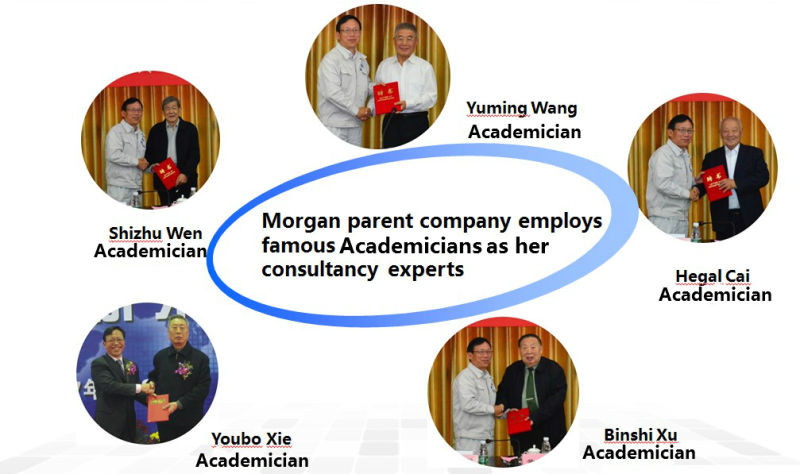
Contact us if you need more details on O Ring. We are ready to answer your questions on packaging, logistics, certification or any other aspects about Seal Ring、O-Ring. If these products fail to match your need, please contact us and we would like to provide relevant information.
Compact design
Easy assembly
Economic solution
Symmetry that reduces the risks of an assembly error
Applications
O-Rings are used in a variety of fields: they are either used as sealing elements or as energizing elements for hydraulic slipper seals and wipers. Thus, the O-Ring is basically used in every field of industry including aerospace, automotive or general engineering. Today, O-rings are one of the most common seals used in machine design because they are inexpensive, easy to make, and reliable and have simple mounting.
Materials
Morgan O-rings Material Includes Nitrile rubber, fluorine rubber, ethylene propylene rubber, neoprene, chloroprene rubber, silicone rubber and so on.
NBR (Nitrile Butadiene Rubber)
Nitrile rubber (NBR) is the general term for acrylonitrile-butadiene copolymer. The ACN content can vary between 18% and 50%. While the acrylonitrile content is important, the resistance to oil and fuel is more so. Conversely, the elasticity and compression set are not as good. The NBR has good mechanical properties and good wear resistance. However, its resistance to atmospheric agents and the ozone is relatively low.
| Chemical resistance | Aliphatic hydrocarbons (propane, butane, petroleum, diesel fuel) Mineral oils and greases Fire-resistant fluids (HFA, HFB and HFC) Diluted acids, alkaline and saline solutions for low temperatures Water (up to +100°C max) |
| Compatibility issue | Fuels with a high aromatic content Aromatic hydrocarbons (benzene) Chlorinated hydrocarbons (trichlorethylene) Polar solvents (ketone, acetone, acetic acid, ethylene-ester) Strong acids Glycol-based brake fluids Atmospheric and ozone agents |
| Temperature range | -30°C / +100°C (short-term peak at +120°C) -40°C / +100°C with special NBRs |

Depending on their structure and fluorine content, fluoroelastomers can vary in terms of chemical resistance and resistance to cold. This FKM-based rubber is very often used for high-temperature hydraulic and pneumatic systems, industrial valves, injection/fuel systems, motor seals and high-vacuum systems.
| Chemical resistance | Mineral oils and greases, ASTM n°1, IRM 902 and IRM 903 oils. Fire-resistant liquids (HFD) Silicone oils and greases Mineral and vegetable oils and greases Aliphatic hydrocarbons (propane, butane, petroleum) Aromatic hydrocarbons (benzene, toluene) Chlorinated hydrocarbons (trichlorethylene) Petrol (including high alcohol content) Atmospheric and ozone agents |
| Compatibility issue | Glycol-based brake fluids Ammoniac gas Organic acids with a low molecular weight (formic and acetic acids) |
| Temperature range | -20°C / +200°C (short-term peak at +230°C) -40°C / +200°C with special FKMs |
As an Ethylene Propylene Diene Monomer copolymer, EPDM is commonly used for hot water taps, cooling systems, brake systems, dishwashers and washing machines.
| Chemical resistance | Hot water and steam up to +150°C Glycol-based brake fluids (Dot 3 & 4) and silicone-based brake fluids (Dot 5) Organic and inorganic acids Cleaning agents, sodium and potassium alkalis Hydraulic fluids (HFD-R) Silicone oils and greases Polar solvents (alcohols, ketones and esters) Atmospheric and ozone agents |
| Compatibility issue | Mineral oils and greases Hydrocarbons Low impermeability to gas |
| Temperature range | -45°C / +150°C (short-term peak at +175°C) |
This HNBR-based elastomer is obtained through selective hydrogenation of the NBR's butadiene groups. It is commonly used for power-assisted steering and for air conditioning.
| Chemical resistance | Aliphatic hydrocarbons Mineral and vegetable oils and greases Fire-resistant fluids (HFA, HFB and HFC) Diluted acids, saline solutions and bases for low temperatures Water and steam up to +150°C Atmospheric and ozone agents |
| Compatibility issue | Chlorinated hydrocarbons Polar solvents (ketones, esters and ethers) Strong acids |
| Temperature range | -30°C / +150°C (short-term peak at +160°C) -40°C / +150°C with special HNBRs |

This FVMQ-based rubber is very often used for fuel systems.
| Chemical resistance | Animal and vegetable oils and greases Moderate water temperature Diluted saline solutions Atmospheric and ozone agents |
| Compatibility issue | Superheated steam up to +120°C Chlorinated hydrocarbons with a low molecular weight (trichlorethylene) Aromatic hydrocarbons (benzene, toluene) |
| Temperature range | -60°C / +200°C (short-term peak at +230°C) |
The FVMQ has mechanical and physical properties that are very similar to those of VMQ. However, the FVMQ offers better resistance to fuels and mineral oils. However, resistance to hot air is not as good as that of VMQ.
| Chemical resistance | Aromatic mineral oils (IRM 903 oil) Fuels Aromatic hydrocarbons with a low molecular weight (benzene, toluene) |
| Temperature range | -70°C / +175°C |
Polymers containing ethyl acrylate (or butyl acrylate) have a small amount of monomer, which is necessary for cross-linking; ACM is a material with better heat resistance than NBR. It is often used for automatic gearboxes.
| Chemical resistance | Mineral oils (motor oils, gear box oils, ATF oils) Atmospheric and ozone agents |
| Compatibility issue | Glycol-based brake fluids (Dot 3 & 4) Aromatic and chlorinated hydrocarbons Water and steam Acids, alkalis and amines |
| Temperature range | -25°C to + 150°C (short-term peak at +160°C) -35°C / +150°C with special ACMs |
As a methyl acrylate and ethylene copolymer, AEM is considered to be better resistant to heat than ACM. Its characteristics make it an intermediary between ACM and FKM.
| Chemical resistance | Coolants Aggressive mineral oils Atmospheric agents Water |
| Compatibility issue | Aromatic solvents Strong acids Brake fluids Gearbox oils ATF oils |
| Temperature range | - 40°C à + 150°C |
This CR-based elastomer is used in the refrigeration industry and for ventilation systems. This chloroprene was the first synthetic rubber to be developed and marketed.
| Chemical resistance | Paraffinic mineral oils Silicone oils and greases Water and water-based solvents for use at low temperatures Refrigerant fluids Ammoniac Carbon dioxide Atmospheric and ozone agents |
| Limited chemical resistance | Naphthenic mineral oils Aliphatic hydrocarbons (propane, butane, petroleum) Glycol-based brake fluids |
| Compatibility issue | Aromatic hydrocarbons (benzene) Chlorinated hydrocarbons (trichlorethylene) Polar solvents (ketone, acetone, acetic acid and ethylene-ester) |
| Temperature range | -40°C / +100°C (short-term peak at +120°C) |
FFKM has the best resistance to high temperatures and an excellent chemical inertia. This FKM-based rubber is very often used for high-temperature hydraulic and pneumatic systems, industrial valves, injection/fuel systems, motor seals and high-vacuum systems.
| Chemical resistance | Aliphatic and aromatic hydrocarbons Polar solvents (ketones, esters, ethers) Organic and inorganic acids Water and steam High-vacuum systems |
| Problème de compatibilité | Coolants (R11, R12, R13, R113, R114, etc.) PFPE |
| Temperature range | -15°C / +320°C |
| Characteristics/Materials | ACM | AEM | CR | EPDM | FFKM | FKM | FVMQ | HNBR | NBR | VMQ |
| Resistance to abrasion | 2 | 3 | 2 | 2 | 4 | 2 | 4 | 2 | 2 | 4 |
| Acid resistant | 4 | 3 | 2 | 2 | 1 | 1 | 3 | 1 | 3 | 3 |
| Resistance to chemicals | 4 | 2 | 2 | 1 | 1 | 1 | 1 | 2 | 2 | 2 |
| Resistance to cold | 4 | 2 | 2 | 2 | 3 | 4 | 2 | 2 | 2 | 2 |
| Dynamic properties | 3 | 3 | 3 | 2 | 3 | 2 | 4 | 1 | 2 | 4 |
| Electrical properties | 3 | 3 | 3 | 2 | 1 | 4 | 1 | 3 | 3 | 1 |
| Resistance to fire | 4 | 4 | 2 | 4 | 1 | 1 | 2 | 4 | 4 | 3 |
| Resistance to heat | 1 | 1 | 2 | 2 | 1 | 1 | 1 | 1 | 2 | 1 |
| Sealing water | 1 | 1 | 2 | 2 | 2 | 2 | 4 | 2 | 2 | 4 |
| Resistance to oil | 1 | 3 | 2 | 4 | 1 | 1 | 2 | 1 | 1 | 2 |
| Resistance to ozone | 1 | 1 | 2 | 1 | 1 | 1 | 1 | 2 | 4 | 1 |
| Resistance to tearing | 2 | 3 | 3 | 1 | 4 | 3 | 4 | 2 | 2 | 4 |
| Tensile strength | 3 | 2 | 2 | 1 | 2 | 1 | 3 | 1 | 2 | 4 |
| Resistance to water / steam | 4 | 4 | 3 | 1 | 2 | 3 | 3 | 1 | 2 | 3 |
| Resistance to atmospheric agents | 1 | 1 | 1 | 1 | 1 | 1 | 1 | 2 | 3 | 1 |
Chemical compatibility
A "Chemical compatibility guide" catalogue can be downloaded from the Literature section. You can also use our online "Chemical compatibility" tool free of charge.
These two tools enable you to measure the behaviour of our materials that come into contact with the majority of existing fluids. The data displayed is the result of rigorous testing at the ambient temperature and takes previous publications into consideration. Test results are not fully representative because of the specific features of your application. The tests performed actually do not consider additives and impurities that may exist under actual conditions of use, nor the potential elevation of temperatures. Other parameters can also alter the behaviour of our materials, such as the hardness, persistence, abrasion, etc. We therefore recommend performing your own tests to verify the compatibility of our materials depending on your specific application. Our technical team can provide you with any additional information.

O ring standard:The o ring sizes are specified by the inside diameter and the cross section diameter. Morgan Rubber O ring seals are manufactured according to metric and imperial international standards such as GB3452.1-92, AS 568B, DIN ISO 3601 and JIS standard. Morgan seals also accept custom sizes of almost any dimension, such as metric o rings, miniature O-rings, special O-rings with large dimensions and continuously moulded and spliced.

Guangzhou Morgan Seals Co., Ltd. has the biggest vulcanizing machine(4000T) and different kinds of seal moulds. So for the non-standard o ring, Oil Seals, Hydraulic Seals, please do not hesitate to contact with us. The following is the the picture Morgan Production Line and Warehouse

Our services:
Guangzhou Morgan Seals Co., Ltd the expert in sealing solution field who combines the rich seals research and production experience of her parent firm with the advanced technology and administration of Morgan, Worcester. Morgan Seals Research and Development ability is based on her parent firm who has won awards as scientific research achievements for more than 1000 projects and over 200 of them won scientific and technological progress prizes of municipal, provincial, ministerial and national levels. At the same time, it also has one National Certified Laboratory, one National Engineering Research Centers and three Industry Level Inspection Centers.

Contact us if you need more details on O Ring. We are ready to answer your questions on packaging, logistics, certification or any other aspects about Seal Ring、O-Ring. If these products fail to match your need, please contact us and we would like to provide relevant information.
Product Categories : O-Rings&O-Ring Kits
Other Products
Hot Products
Fabric Reinforced Polyester Wear Strip/RingsPolyurethane Spring Energized SealsQuality Assurance Machine Tool Soft BandsPhenolic Resin Hard Tape with Special DesignTandem Seal for Rod - Gtdi SealsSpring Energized Seal PTFE for Pump/ValveCarbon Filled PTFE Spring Energizes Seals for HydraulicVee Packing Set SealsMechanical PU Piston Seal, Piston Seal U Cup-YxdTeflon Spring Seal (PTU/ PTA/ PTB)Leading Product Hydraulic PTFE Rod SealWear Ring and Guide Tape (GST)PTFE Guide Strip Bearing Strips for Pump Guide StripPTFE+Bronze Piston Seal for Machine ToolsTeflon Spring Energized Seals for Mobile HydraulicPhenolic with Fabric Hard Tape (CG010)


